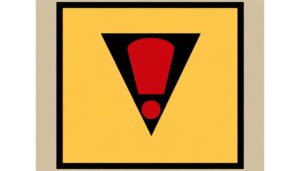What Is the Meaning of the Gas Under Pressure Symbol?
The gas under pressure symbol indicates the existence of compressed, liquefied, or dissolved gases. It shows a gas cylinder on a diamond or rectangular background and is standardized under systems such as the Globally Harmonized System (GHS).
This symbol warns of potential hazards, including explosions and physical injuries, ensuring workplace safety and regulatory compliance. Recognizing this symbol is crucial for mitigating risks associated with handling pressurized gases.
Thorough training in hazard identification and emergency response further improves safety measures. Ongoing knowledge in this area is essential for maintaining strict safety standards and efficient hazard management.
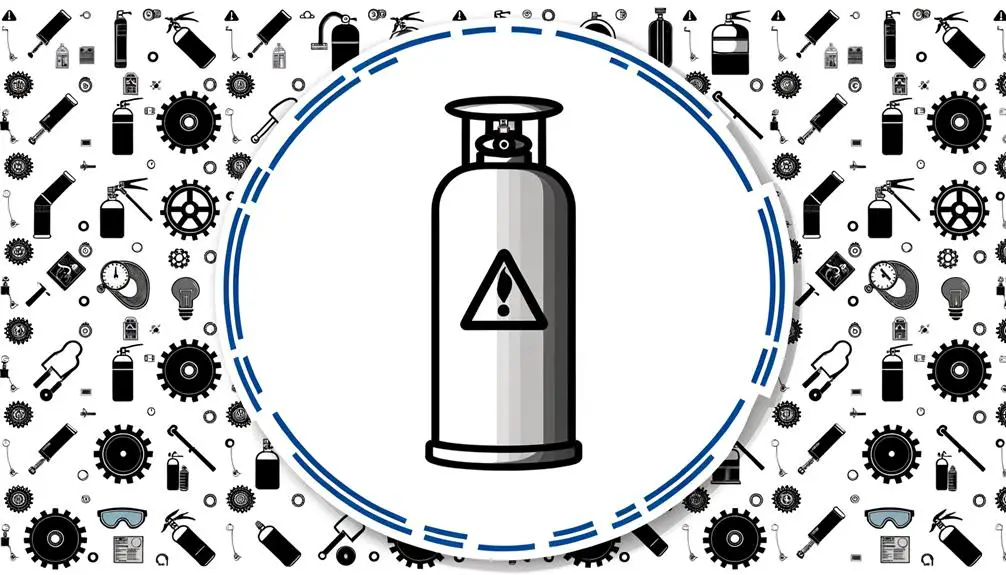
Key Takeaways
- The gas under pressure symbol indicates the presence of compressed, liquefied, or dissolved gases.
- It features a gas cylinder against a diamond or rectangular background to convey hazard risks.
- The symbol warns about potential explosion hazards and physical injuries due to high pressure.
- Recognizing this symbol is crucial for maintaining workplace safety and regulatory compliance.
- It is standardized under guidelines like GHS to ensure uniform hazard communication across industries.
Symbol Description
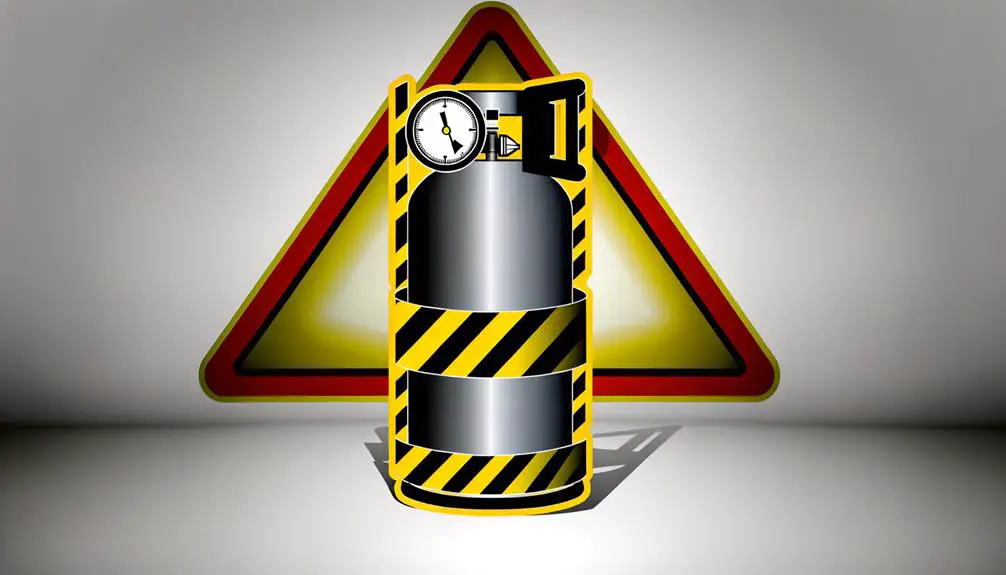
The gas under pressure symbol, typically depicted as a gas cylinder, serves as a critical visual cue indicating the presence of compressed, liquefied, or dissolved gases. This symbol is standardized under globally recognized guidelines, such as the Globally Harmonized System of Classification and Labeling of Chemicals (GHS).
It features a simplistic, yet unmistakable image of a single gas cylinder, often set against a diamond or rectangular background for enhanced visibility. The design aims to convey the potential risks associated with high-pressure gases, which may include explosion hazards and physical injuries.
The symbol's straightforward representation ensures that it can be easily identified and understood by personnel across different industries, thereby promoting safety and compliance with regulatory standards.
Hazard Identification
Effective hazard identification begins with recognizing standardized hazard symbols, which are essential for identifying gases under pressure. Understanding the specific risks associated with pressure, such as potential explosions or equipment failure, is necessary for ensuring workplace safety.
Implementing appropriate safety precaution measures, including proper storage and handling protocols, reduces these risks considerably.
Recognizing Hazard Symbols
Identifying hazard symbols is crucial for maintaining safety and compliance in environments where hazardous materials are present. The gas under pressure symbol, a cylinder, indicates containers of gases stored at high pressure. Recognizing this symbol quickly informs personnel of the potential hazards associated with gas leakage or explosion.
It is crucial to understand that these symbols adhere to international standards, such as those provided by the Globally Harmonized System (GHS) for classification and labeling. Proper training in the recognition of these symbols guarantees that employees can take appropriate precautionary measures.
This proficiency in hazard identification not only mitigates risks but also ensures adherence to regulatory requirements, thereby fostering a safer work environment.
Understanding Pressure Risks
Understanding pressure risks involves a detailed analysis of the potential hazards associated with the storage and handling of pressurized gases. Pressurized gases can pose significant physical dangers, including explosions, due to the high pressure contained within cylinders or tanks. The release of these gases, whether controlled or accidental, can result in rapid decompression, leading to equipment failure or personal injury.
Additionally, certain gases are flammable, toxic, or corrosive, compounding the risks. Identifying these hazards requires examining factors such as gas type, storage conditions, and vessel integrity. Recognizing the signs of wear, corrosion, or faulty pressure relief mechanisms is crucial in mitigating risks.
Thorough hazard identification forms the foundation for developing effective safety protocols and emergency response measures.
Safety Precaution Measures
Implementing safety precaution measures requires a systematic approach to hazard identification that thoroughly evaluates all potential risks associated with pressurized gas systems. This process involves conducting thorough risk assessments to identify the nature and magnitude of hazards, such as leaks, ruptures, and improper handling.
Utilization of advanced detection technologies, such as gas sensors and pressure monitoring systems, is crucial for early hazard identification. Additionally, adherence to industry standards and regulations, including strong maintenance protocols, guarantees the integrity of gas containment systems.
Training personnel in hazard recognition and emergency response procedures further reduces risks. The integration of these measures creates a robust safety framework, essential for preventing accidents and maintaining operational continuity in environments dealing with pressurized gases.
Regulatory Standards
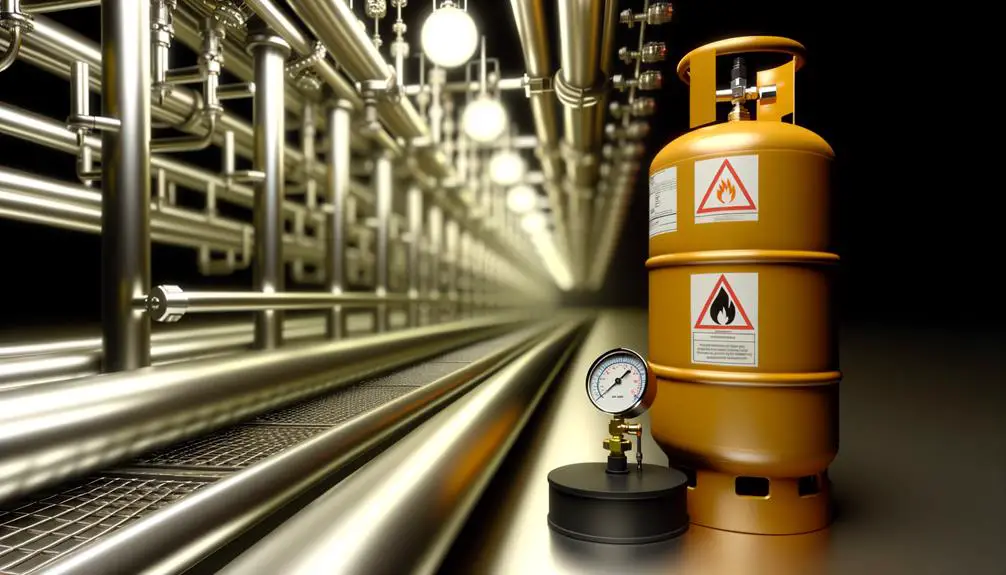
Regulatory standards for gas under pressure symbols are established to guarantee uniformity and safety in labeling across industries. These standards maintain that symbols are universally recognized, thereby minimizing risks associated with handling pressurized gases.
Key organizations like OSHA, ANSI, and ISO define these regulations.
- OSHA (Occupational Safety and Health Administration): Mandates safety symbols for workplace hazards.
- ANSI (American National Standards Institute): Provides guidelines for standardized labeling.
- ISO (International Organization for Standardization): Secures global consistency in safety symbols.
- GHS (Globally Harmonized System): Standardizes classification and labeling of chemicals.
- DOT (Department of Transportation): Regulates transport-related safety symbols.
Adherence to these standards is essential for operational safety and legal compliance, guaranteeing that personnel can quickly and accurately identify hazards.
Safety Precautions
Proper safety precautions are crucial to mitigate the risks associated with handling gases under pressure. Key measures include employing appropriate personal protective equipment (PPE), such as gloves and face shields, to prevent injuries from accidental releases.
Storage protocols necessitate securing cylinders in an upright position, away from heat sources and ensuring proper ventilation to avoid gas accumulation. Regular inspection and maintenance of equipment are imperative to detect leaks or wear.
Adherence to standardized procedures for transportation, such as using approved containers and clear labeling, enhances safety. Emergency response plans must be established, including evacuation routes and first-aid measures.
Implementing these practices notably reduces the potential hazards linked to pressurized gases, ensuring a safer working environment.
Common Applications
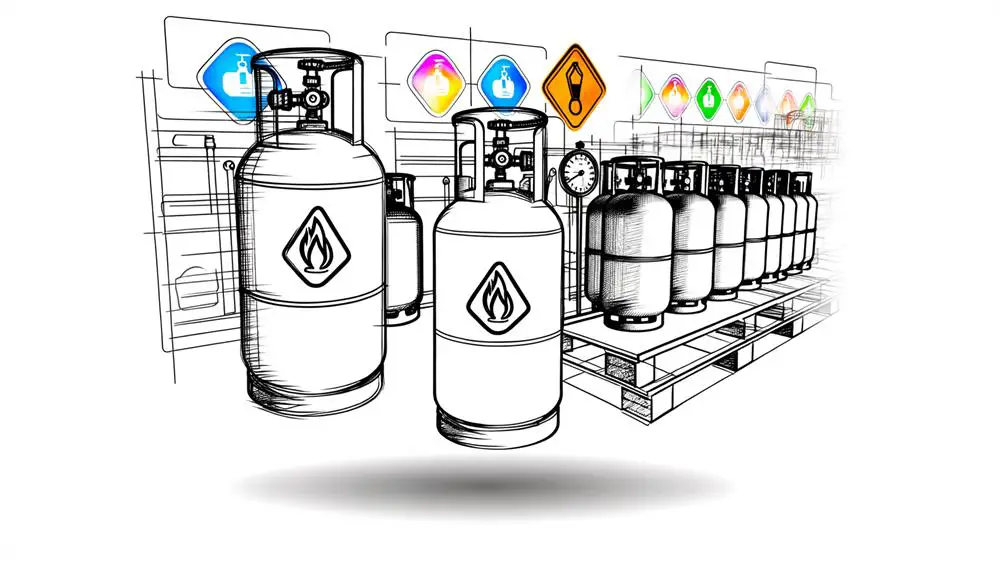
Pressurized gases are essential to numerous industrial applications, including welding, medical anesthesia, and chemical synthesis. Their critical role in these areas cannot be overstated due to their unique properties and functionalities.
Common applications include:
- Welding and Cutting: Utilized for oxy-fuel welding and cutting metals.
- Medical Anesthesia: Essential in providing controlled anesthesia in surgical procedures.
- Chemical Synthesis: Functions as reactants or catalysts in various chemical processes.
- Food and Beverage: Used in carbonation of soft drinks and preservation of perishables.
- Laboratory Research: Essential for conducting experiments and maintaining controlled environments.
These gases are typically stored under high pressure to ensure efficient delivery and consistent performance in these applications, underscoring the importance of proper handling and safety measures.
Emergency Response
Given the extensive use of pressurized gases across various industries, it is essential to implement effective emergency response protocols to mitigate risks associated with accidental leaks or equipment failures.
Rapid identification of gas leaks through continuous monitoring systems and gas detection alarms is vital. Personnel should be trained in immediate evacuation procedures and the use of personal protective equipment (PPE).
Emergency shutoff valves and automated shutdown systems can prevent escalation. Coordination with local emergency services guarantees prompt response.
Regular drills and adherence to safety standards like OSHA and NFPA guidelines enhance preparedness. Thorough risk assessments and maintenance schedules further reduce the likelihood of hazardous events, ensuring a safer working environment.
Conclusion
To sum up, the gas under pressure symbol, a seemingly innocuous graphic, serves as a beacon of regulatory compliance, safety protocols, and industrial prudence.
It functions not just as a warning but as a demonstration of the labyrinthine regulations that govern hazardous materials.
It is an emblem of human ingenuity, where one must navigate a complex web of standards to avoid the rather undesirable consequence of an unplanned rocket launch.
This symbolizes the quintessence of modern safety culture.






